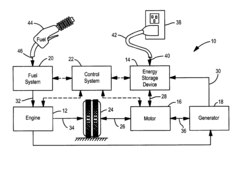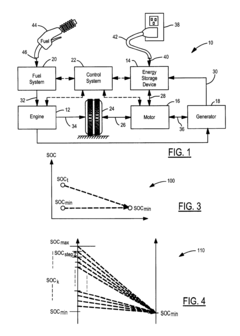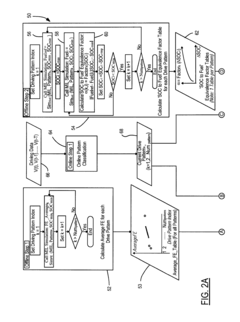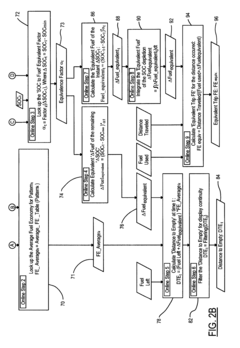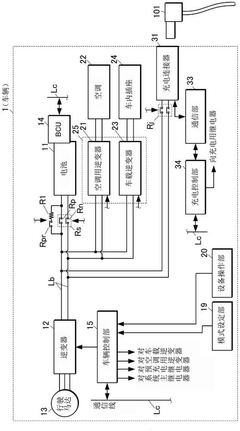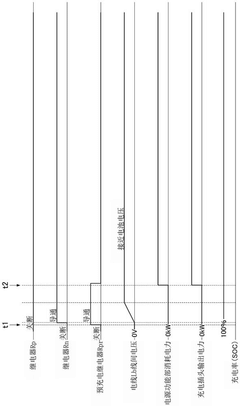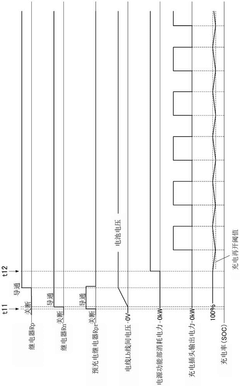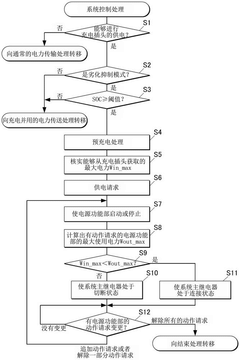PHEV role in public transport vehicle electrification
AUG 14, 20259 MIN READ
Generate Your Research Report Instantly with AI Agent
Patsnap Eureka helps you evaluate technical feasibility & market potential.
PHEV Technology Evolution
The evolution of Plug-in Hybrid Electric Vehicle (PHEV) technology in public transport has been marked by significant advancements and milestones over the past two decades. Initially, PHEVs were introduced as a bridge technology between conventional internal combustion engine vehicles and fully electric vehicles, offering a compromise between range anxiety and emission reduction.
In the early 2000s, the first generation of PHEV buses featured simple parallel hybrid systems with limited electric-only range. These vehicles primarily relied on regenerative braking to charge their small battery packs, offering modest fuel economy improvements over traditional diesel buses.
The mid-2000s saw the introduction of series-parallel hybrid systems in PHEVs, allowing for more efficient power management and increased electric-only operation. This period also marked the beginning of larger battery capacities, extending the electric range to 20-30 kilometers.
By the early 2010s, advancements in battery technology, particularly lithium-ion chemistries, led to a significant leap in PHEV capabilities. Battery capacities increased substantially, enabling electric ranges of 50-70 kilometers. This improvement made PHEVs more viable for urban public transport routes, where they could operate in all-electric mode for a significant portion of their daily cycles.
The mid-2010s brought about the integration of smart charging systems and vehicle-to-grid (V2G) capabilities in PHEV buses. These technologies allowed for more efficient energy management and the potential for PHEVs to serve as mobile power sources during emergencies or peak demand periods.
Recent years have seen a focus on optimizing powertrain efficiency and reducing the overall weight of PHEV buses. Advanced power electronics, more efficient electric motors, and lightweight materials have contributed to extended electric ranges and improved fuel economy in hybrid mode.
Current state-of-the-art PHEV buses boast electric ranges exceeding 100 kilometers, with some models approaching 150 kilometers. This significant improvement has made PHEVs increasingly competitive with battery electric buses on many routes, especially those requiring longer ranges or operating in areas with limited charging infrastructure.
Looking ahead, the evolution of PHEV technology in public transport is expected to continue, with a focus on further extending electric range, improving overall efficiency, and integrating advanced connectivity and autonomous driving features. These developments aim to solidify the role of PHEVs as a crucial component in the electrification of public transport fleets, particularly in scenarios where full electrification faces infrastructure or operational challenges.
In the early 2000s, the first generation of PHEV buses featured simple parallel hybrid systems with limited electric-only range. These vehicles primarily relied on regenerative braking to charge their small battery packs, offering modest fuel economy improvements over traditional diesel buses.
The mid-2000s saw the introduction of series-parallel hybrid systems in PHEVs, allowing for more efficient power management and increased electric-only operation. This period also marked the beginning of larger battery capacities, extending the electric range to 20-30 kilometers.
By the early 2010s, advancements in battery technology, particularly lithium-ion chemistries, led to a significant leap in PHEV capabilities. Battery capacities increased substantially, enabling electric ranges of 50-70 kilometers. This improvement made PHEVs more viable for urban public transport routes, where they could operate in all-electric mode for a significant portion of their daily cycles.
The mid-2010s brought about the integration of smart charging systems and vehicle-to-grid (V2G) capabilities in PHEV buses. These technologies allowed for more efficient energy management and the potential for PHEVs to serve as mobile power sources during emergencies or peak demand periods.
Recent years have seen a focus on optimizing powertrain efficiency and reducing the overall weight of PHEV buses. Advanced power electronics, more efficient electric motors, and lightweight materials have contributed to extended electric ranges and improved fuel economy in hybrid mode.
Current state-of-the-art PHEV buses boast electric ranges exceeding 100 kilometers, with some models approaching 150 kilometers. This significant improvement has made PHEVs increasingly competitive with battery electric buses on many routes, especially those requiring longer ranges or operating in areas with limited charging infrastructure.
Looking ahead, the evolution of PHEV technology in public transport is expected to continue, with a focus on further extending electric range, improving overall efficiency, and integrating advanced connectivity and autonomous driving features. These developments aim to solidify the role of PHEVs as a crucial component in the electrification of public transport fleets, particularly in scenarios where full electrification faces infrastructure or operational challenges.
Public Transport Market Analysis
The public transport market has been experiencing significant shifts in recent years, driven by urbanization, environmental concerns, and technological advancements. The global public transport market size was valued at $74.3 billion in 2022 and is projected to grow at a CAGR of 7.2% from 2023 to 2030. This growth is primarily attributed to increasing government initiatives to reduce carbon emissions and improve urban mobility.
In the context of vehicle electrification, the public transport sector has been at the forefront of adopting new technologies. Electric buses have gained substantial traction, with the global electric bus market expected to reach $71.5 billion by 2027. However, the transition to fully electric vehicles in public transport faces challenges such as high upfront costs, limited range, and inadequate charging infrastructure.
This is where Plug-in Hybrid Electric Vehicles (PHEVs) play a crucial role in the electrification of public transport. PHEVs offer a bridge technology between conventional internal combustion engine vehicles and fully electric vehicles. They provide the benefits of electric propulsion for short-distance urban routes while maintaining the flexibility of longer-range operations using conventional fuel.
The market for PHEV buses is growing, with several major manufacturers introducing PHEV models. These vehicles are particularly attractive for cities and transit agencies looking to reduce emissions and fuel costs without the need for extensive charging infrastructure. The PHEV bus market is expected to grow at a CAGR of 5.9% from 2023 to 2030.
Demand for PHEVs in public transport is driven by several factors. Firstly, they offer a practical solution for routes that require both short urban trips and longer intercity journeys. Secondly, they provide a lower-risk option for transit agencies to transition towards electrification without committing to a full electric fleet. Lastly, PHEVs can help agencies meet increasingly stringent emissions regulations while managing operational costs.
Regional variations in PHEV adoption for public transport are notable. Europe leads in PHEV bus deployments, followed by North America and Asia-Pacific. China, in particular, has seen rapid growth in electric and hybrid bus adoption, driven by strong government support and domestic manufacturing capabilities.
Looking ahead, the role of PHEVs in public transport electrification is expected to evolve. While they currently serve as a transitional technology, their market share may decline as battery technology improves and charging infrastructure expands. However, PHEVs are likely to maintain a significant presence in specific market segments, such as long-distance routes or areas with limited charging infrastructure, for the foreseeable future.
In the context of vehicle electrification, the public transport sector has been at the forefront of adopting new technologies. Electric buses have gained substantial traction, with the global electric bus market expected to reach $71.5 billion by 2027. However, the transition to fully electric vehicles in public transport faces challenges such as high upfront costs, limited range, and inadequate charging infrastructure.
This is where Plug-in Hybrid Electric Vehicles (PHEVs) play a crucial role in the electrification of public transport. PHEVs offer a bridge technology between conventional internal combustion engine vehicles and fully electric vehicles. They provide the benefits of electric propulsion for short-distance urban routes while maintaining the flexibility of longer-range operations using conventional fuel.
The market for PHEV buses is growing, with several major manufacturers introducing PHEV models. These vehicles are particularly attractive for cities and transit agencies looking to reduce emissions and fuel costs without the need for extensive charging infrastructure. The PHEV bus market is expected to grow at a CAGR of 5.9% from 2023 to 2030.
Demand for PHEVs in public transport is driven by several factors. Firstly, they offer a practical solution for routes that require both short urban trips and longer intercity journeys. Secondly, they provide a lower-risk option for transit agencies to transition towards electrification without committing to a full electric fleet. Lastly, PHEVs can help agencies meet increasingly stringent emissions regulations while managing operational costs.
Regional variations in PHEV adoption for public transport are notable. Europe leads in PHEV bus deployments, followed by North America and Asia-Pacific. China, in particular, has seen rapid growth in electric and hybrid bus adoption, driven by strong government support and domestic manufacturing capabilities.
Looking ahead, the role of PHEVs in public transport electrification is expected to evolve. While they currently serve as a transitional technology, their market share may decline as battery technology improves and charging infrastructure expands. However, PHEVs are likely to maintain a significant presence in specific market segments, such as long-distance routes or areas with limited charging infrastructure, for the foreseeable future.
PHEV Challenges in Public Transport
While Plug-in Hybrid Electric Vehicles (PHEVs) offer a promising solution for the electrification of public transport, they face several significant challenges in this sector. One of the primary obstacles is the high initial cost of PHEV technology compared to conventional diesel buses. The complex powertrain, including both an internal combustion engine and an electric motor, along with a large battery pack, contributes to elevated manufacturing expenses. This cost barrier can be particularly prohibitive for budget-constrained public transport operators.
Another challenge lies in the operational complexity of PHEVs in public transport settings. Fleet managers must optimize the use of both electric and combustion modes to maximize efficiency and minimize emissions. This requires sophisticated route planning and driver training to ensure that the electric range is utilized effectively, particularly in urban areas where air quality concerns are paramount.
The charging infrastructure for PHEVs in public transport also presents significant hurdles. Unlike personal vehicles, public transport PHEVs require more frequent and faster charging due to their continuous operation. Implementing adequate charging stations at depots and strategic locations along routes can be logistically challenging and costly, especially in cities with limited space or older infrastructure.
Maintenance and reliability concerns also pose challenges for PHEV adoption in public transport. The dual powertrain system increases the complexity of maintenance procedures and may require specialized training for technicians. Additionally, the long-term durability of PHEV components, particularly the battery systems, under the demanding conditions of public transport operations remains a concern for fleet operators.
Weight considerations present another challenge for PHEVs in public transport. The addition of battery packs and electric drivetrain components can significantly increase the overall weight of the vehicle, potentially reducing passenger capacity or requiring structural modifications to comply with road regulations. This weight increase can also impact the vehicle's range and efficiency, particularly in stop-and-go urban traffic conditions typical of public transport routes.
Furthermore, the environmental benefits of PHEVs in public transport can be complex to quantify and communicate. While they offer reduced emissions compared to conventional buses, their overall environmental impact depends heavily on factors such as the local electricity grid's carbon intensity and the proportion of electric versus combustion mode usage. This complexity can make it challenging for policymakers and the public to fully appreciate the environmental advantages of PHEV adoption in public transport fleets.
Lastly, the rapid evolution of battery technology and fully electric vehicles poses a strategic challenge for PHEV implementation in public transport. As battery costs decrease and ranges improve, some operators may question the long-term viability of PHEVs compared to fully electric buses, potentially hesitating to invest in what could be seen as an interim technology.
Another challenge lies in the operational complexity of PHEVs in public transport settings. Fleet managers must optimize the use of both electric and combustion modes to maximize efficiency and minimize emissions. This requires sophisticated route planning and driver training to ensure that the electric range is utilized effectively, particularly in urban areas where air quality concerns are paramount.
The charging infrastructure for PHEVs in public transport also presents significant hurdles. Unlike personal vehicles, public transport PHEVs require more frequent and faster charging due to their continuous operation. Implementing adequate charging stations at depots and strategic locations along routes can be logistically challenging and costly, especially in cities with limited space or older infrastructure.
Maintenance and reliability concerns also pose challenges for PHEV adoption in public transport. The dual powertrain system increases the complexity of maintenance procedures and may require specialized training for technicians. Additionally, the long-term durability of PHEV components, particularly the battery systems, under the demanding conditions of public transport operations remains a concern for fleet operators.
Weight considerations present another challenge for PHEVs in public transport. The addition of battery packs and electric drivetrain components can significantly increase the overall weight of the vehicle, potentially reducing passenger capacity or requiring structural modifications to comply with road regulations. This weight increase can also impact the vehicle's range and efficiency, particularly in stop-and-go urban traffic conditions typical of public transport routes.
Furthermore, the environmental benefits of PHEVs in public transport can be complex to quantify and communicate. While they offer reduced emissions compared to conventional buses, their overall environmental impact depends heavily on factors such as the local electricity grid's carbon intensity and the proportion of electric versus combustion mode usage. This complexity can make it challenging for policymakers and the public to fully appreciate the environmental advantages of PHEV adoption in public transport fleets.
Lastly, the rapid evolution of battery technology and fully electric vehicles poses a strategic challenge for PHEV implementation in public transport. As battery costs decrease and ranges improve, some operators may question the long-term viability of PHEVs compared to fully electric buses, potentially hesitating to invest in what could be seen as an interim technology.
Current PHEV Solutions
01 Power management systems for PHEVs
Advanced power management systems are crucial for optimizing the performance of plug-in hybrid electric vehicles. These systems control the distribution of power between the electric motor and internal combustion engine, manage battery charging, and improve overall energy efficiency. They also incorporate intelligent algorithms to predict and adapt to driving conditions, enhancing the vehicle's range and fuel economy.- Power management systems for PHEVs: Advanced power management systems are crucial for optimizing the performance of plug-in hybrid electric vehicles. These systems control the distribution of power between the electric motor and internal combustion engine, manage battery charging, and improve overall energy efficiency. They often incorporate intelligent algorithms to predict driving conditions and adjust power output accordingly.
- Charging infrastructure for PHEVs: The development of efficient charging infrastructure is essential for the widespread adoption of PHEVs. This includes the design of charging stations, integration with smart grids, and implementation of fast-charging technologies. Innovations in this area focus on reducing charging times, improving accessibility, and enhancing the overall user experience for PHEV owners.
- Battery technology advancements for PHEVs: Continuous improvements in battery technology are crucial for enhancing the performance and range of PHEVs. This includes the development of high-capacity batteries, improved thermal management systems, and advanced battery management systems. Research in this area aims to increase energy density, reduce charging times, and extend battery life cycles.
- Drivetrain and transmission systems for PHEVs: Innovative drivetrain and transmission systems are being developed to optimize the integration of electric motors and internal combustion engines in PHEVs. These systems aim to improve power delivery, reduce energy losses, and enhance overall vehicle efficiency. Advanced designs often incorporate multiple operating modes to suit various driving conditions.
- Control strategies for PHEVs: Sophisticated control strategies are essential for maximizing the efficiency and performance of PHEVs. These strategies involve optimizing the interplay between the electric motor and internal combustion engine, managing energy recuperation during braking, and adapting to different driving modes. Advanced control systems often utilize artificial intelligence and machine learning algorithms to continuously improve vehicle performance.
02 Charging infrastructure and methods for PHEVs
Developing efficient charging infrastructure is essential for the widespread adoption of PHEVs. This includes the design of charging stations, integration with smart grid systems, and implementation of fast-charging technologies. Advanced charging methods, such as wireless charging and vehicle-to-grid (V2G) systems, are being explored to enhance convenience and grid stability.Expand Specific Solutions03 Hybrid powertrain configurations
Various hybrid powertrain configurations are being developed to optimize PHEV performance. These include series, parallel, and power-split architectures, each offering different advantages in terms of efficiency, power delivery, and cost. Advanced transmission systems and clutch mechanisms are also being designed to seamlessly integrate electric and combustion power sources.Expand Specific Solutions04 Battery technology for PHEVs
Advancements in battery technology are crucial for improving PHEV performance and range. Research focuses on developing high-energy-density batteries, improving thermal management, and enhancing battery life cycles. New materials and cell designs are being explored to increase energy storage capacity while reducing weight and cost.Expand Specific Solutions05 Control strategies for PHEVs
Sophisticated control strategies are being developed to optimize PHEV operation. These include predictive energy management systems, adaptive control algorithms, and integration with vehicle connectivity and navigation systems. Advanced control strategies aim to maximize electric-only driving range, minimize emissions, and enhance overall vehicle efficiency based on real-time data and driving conditions.Expand Specific Solutions
Key PHEV Manufacturers
The PHEV role in public transport vehicle electrification is in a transitional phase, with the market showing steady growth as cities worldwide seek to reduce emissions and improve air quality. The technology's maturity varies among key players, with established automotive giants like Ford, GM, and Hyundai leading the way. Companies such as Johnson Controls and Cummins are contributing to advancements in battery and powertrain technologies. The market is expected to expand further as infrastructure improves and costs decrease. However, competition from fully electric buses is intensifying, potentially impacting long-term PHEV adoption in public transport.
Hyundai Motor Co., Ltd.
Technical Solution: Hyundai has developed a comprehensive PHEV system for public transport vehicles, focusing on buses. Their technology integrates a high-capacity battery pack with a downsized internal combustion engine, optimized for urban driving cycles. The system employs advanced power management algorithms to seamlessly switch between electric and hybrid modes, maximizing efficiency[1]. Hyundai's PHEV buses utilize regenerative braking to recover energy during frequent stops, significantly extending the electric range. The company has also implemented fast-charging capabilities, allowing for quick recharges during short layovers[3]. Additionally, Hyundai has developed a telematics system that provides real-time data on vehicle performance, energy consumption, and route optimization, enabling fleet operators to maximize the benefits of electrification[5].
Strengths: Extensive experience in vehicle electrification, established presence in public transport sector, advanced power management systems. Weaknesses: Higher initial cost compared to conventional buses, potential range limitations in certain operating conditions.
GM Global Technology Operations LLC
Technical Solution: GM has developed a scalable PHEV platform for public transport applications, with a focus on flexibility and adaptability. Their system utilizes a modular battery design that can be easily scaled to meet the specific needs of different vehicle sizes and route requirements[2]. GM's PHEV technology incorporates a smart energy management system that optimizes the use of electric and combustion power based on real-time data and predictive algorithms. This system takes into account factors such as route topology, traffic conditions, and passenger load to maximize efficiency[4]. GM has also integrated vehicle-to-grid (V2G) capabilities, allowing PHEV buses to serve as mobile power sources during emergencies or peak demand periods[6]. Furthermore, GM's PHEV buses feature advanced thermal management systems to ensure optimal battery performance and longevity in various climate conditions.
Strengths: Scalable and flexible platform, advanced energy management system, V2G capabilities. Weaknesses: Limited track record in public transport sector compared to traditional bus manufacturers, potential complexity in maintenance and repairs.
PHEV Core Technologies
Plug-in hybrid electric vehicle and method of control for providing distance to empty and equivalent trip fuel economy information
PatentActiveUS8406948B2
Innovation
- A method for calculating DTE and equivalent Trip Fuel Economy (FE) that involves a controller determining the battery equivalent fuel amount using an equivalence factor based on SOC and driving conditions, and converting electricity consumption into fuel consumption for a unified efficiency index in miles per gallon (MPG), leveraging existing driving pattern identification and high-fidelity PHEV models to provide accurate and adaptive readouts.
vehicle
PatentActiveCN111746277B
Innovation
- After the battery is charged, the pre-charge process is performed by using the pre-charge relay and the control unit to increase the voltage of the wire, and convert the power transmission mode to the direct transmission mode, obtain the power supply power from the external power supply to the power supply function unit to avoid repeated discharge. and charge.
Environmental Impact Assessment
The environmental impact assessment of Plug-in Hybrid Electric Vehicles (PHEVs) in public transport electrification reveals both positive and negative effects on urban ecosystems and global climate change mitigation efforts. PHEVs offer a significant reduction in tailpipe emissions compared to conventional internal combustion engine vehicles, particularly in urban areas where air quality is a major concern. This reduction in local pollutants such as particulate matter, nitrogen oxides, and carbon monoxide can lead to improved air quality and associated health benefits for urban populations.
From a lifecycle perspective, PHEVs in public transport can contribute to reduced greenhouse gas emissions, especially when charged with electricity from renewable sources. The ability to operate in all-electric mode for short distances makes them particularly suitable for urban routes with frequent stops. However, the environmental benefits of PHEVs are highly dependent on the electricity grid mix and charging infrastructure availability.
The production phase of PHEVs does present some environmental challenges, primarily related to battery manufacturing. The extraction and processing of raw materials for batteries, such as lithium, cobalt, and nickel, can have significant environmental impacts, including habitat destruction, water pollution, and greenhouse gas emissions. However, advancements in battery technology and recycling processes are gradually mitigating these concerns.
Noise pollution reduction is another positive environmental impact of PHEVs in public transport. The electric mode operation significantly reduces noise levels, particularly beneficial in densely populated urban areas and during night-time operations. This can contribute to improved quality of life for city residents and reduced stress on urban wildlife.
The flexibility of PHEVs in switching between electric and hybrid modes can help optimize energy use and reduce overall emissions in various driving conditions. This adaptability makes them particularly suitable for diverse public transport routes, including those that extend beyond urban centers where charging infrastructure might be limited.
However, the environmental benefits of PHEVs in public transport are not without challenges. The reliance on fossil fuels for the hybrid mode operation still contributes to some level of emissions, albeit reduced compared to conventional vehicles. Additionally, the increased complexity of PHEV powertrains may lead to higher maintenance requirements and potentially shorter vehicle lifespans, which could offset some of the environmental gains over the vehicle's lifecycle.
In conclusion, while PHEVs offer significant environmental benefits for public transport electrification, particularly in urban settings, their overall impact depends on various factors including energy sources, infrastructure, and lifecycle considerations. Continuous improvements in technology and grid decarbonization will be crucial in maximizing the positive environmental impact of PHEVs in public transport systems.
From a lifecycle perspective, PHEVs in public transport can contribute to reduced greenhouse gas emissions, especially when charged with electricity from renewable sources. The ability to operate in all-electric mode for short distances makes them particularly suitable for urban routes with frequent stops. However, the environmental benefits of PHEVs are highly dependent on the electricity grid mix and charging infrastructure availability.
The production phase of PHEVs does present some environmental challenges, primarily related to battery manufacturing. The extraction and processing of raw materials for batteries, such as lithium, cobalt, and nickel, can have significant environmental impacts, including habitat destruction, water pollution, and greenhouse gas emissions. However, advancements in battery technology and recycling processes are gradually mitigating these concerns.
Noise pollution reduction is another positive environmental impact of PHEVs in public transport. The electric mode operation significantly reduces noise levels, particularly beneficial in densely populated urban areas and during night-time operations. This can contribute to improved quality of life for city residents and reduced stress on urban wildlife.
The flexibility of PHEVs in switching between electric and hybrid modes can help optimize energy use and reduce overall emissions in various driving conditions. This adaptability makes them particularly suitable for diverse public transport routes, including those that extend beyond urban centers where charging infrastructure might be limited.
However, the environmental benefits of PHEVs in public transport are not without challenges. The reliance on fossil fuels for the hybrid mode operation still contributes to some level of emissions, albeit reduced compared to conventional vehicles. Additionally, the increased complexity of PHEV powertrains may lead to higher maintenance requirements and potentially shorter vehicle lifespans, which could offset some of the environmental gains over the vehicle's lifecycle.
In conclusion, while PHEVs offer significant environmental benefits for public transport electrification, particularly in urban settings, their overall impact depends on various factors including energy sources, infrastructure, and lifecycle considerations. Continuous improvements in technology and grid decarbonization will be crucial in maximizing the positive environmental impact of PHEVs in public transport systems.
Policy and Incentives
The role of Plug-in Hybrid Electric Vehicles (PHEVs) in public transport electrification is significantly influenced by policy frameworks and incentive programs. Governments worldwide are implementing various measures to promote the adoption of PHEVs in public transportation fleets, recognizing their potential to reduce emissions and improve energy efficiency.
Financial incentives play a crucial role in encouraging the uptake of PHEVs in public transport. Many countries offer subsidies, tax credits, or grants to transit agencies for purchasing PHEV buses. These incentives help offset the higher initial costs associated with PHEV technology, making them more competitive with conventional diesel buses.
Regulatory policies also drive PHEV adoption in public transport. Emission standards and low-emission zones in urban areas create a favorable environment for PHEV deployment. Some cities have implemented mandates requiring a certain percentage of new bus purchases to be electric or hybrid, further stimulating PHEV integration into public transport fleets.
Infrastructure support is another key policy area. Governments are investing in charging infrastructure development, including the installation of charging stations at bus depots and along routes. This infrastructure support is essential for the successful operation of PHEVs in public transport systems.
Procurement policies are being adapted to favor PHEVs. Many transit agencies are incorporating total cost of ownership (TCO) calculations into their procurement processes, which often highlight the long-term cost benefits of PHEVs over conventional vehicles. Some governments have introduced green procurement guidelines that prioritize low-emission vehicles in public tenders.
Research and development support is also a critical component of PHEV-related policies. Governments are funding research programs and pilot projects to improve PHEV technology specifically for public transport applications. These initiatives aim to enhance performance, reduce costs, and address technical challenges unique to public transport operations.
Public-private partnerships are being encouraged through policy frameworks. These partnerships facilitate collaboration between transit agencies, vehicle manufacturers, and energy providers, accelerating PHEV integration in public transport. Such collaborations often result in innovative financing models and tailored solutions for specific urban contexts.
Training and capacity building programs are being implemented to support the transition to PHEVs. These initiatives aim to equip transit operators and maintenance staff with the necessary skills to operate and maintain PHEV fleets effectively. Some policies include provisions for workforce development to ensure a smooth transition to new technologies.
Overall, the policy landscape for PHEVs in public transport is multifaceted, combining financial incentives, regulatory measures, infrastructure support, and capacity building initiatives. These policies are crucial in overcoming barriers to PHEV adoption and accelerating the electrification of public transport fleets.
Financial incentives play a crucial role in encouraging the uptake of PHEVs in public transport. Many countries offer subsidies, tax credits, or grants to transit agencies for purchasing PHEV buses. These incentives help offset the higher initial costs associated with PHEV technology, making them more competitive with conventional diesel buses.
Regulatory policies also drive PHEV adoption in public transport. Emission standards and low-emission zones in urban areas create a favorable environment for PHEV deployment. Some cities have implemented mandates requiring a certain percentage of new bus purchases to be electric or hybrid, further stimulating PHEV integration into public transport fleets.
Infrastructure support is another key policy area. Governments are investing in charging infrastructure development, including the installation of charging stations at bus depots and along routes. This infrastructure support is essential for the successful operation of PHEVs in public transport systems.
Procurement policies are being adapted to favor PHEVs. Many transit agencies are incorporating total cost of ownership (TCO) calculations into their procurement processes, which often highlight the long-term cost benefits of PHEVs over conventional vehicles. Some governments have introduced green procurement guidelines that prioritize low-emission vehicles in public tenders.
Research and development support is also a critical component of PHEV-related policies. Governments are funding research programs and pilot projects to improve PHEV technology specifically for public transport applications. These initiatives aim to enhance performance, reduce costs, and address technical challenges unique to public transport operations.
Public-private partnerships are being encouraged through policy frameworks. These partnerships facilitate collaboration between transit agencies, vehicle manufacturers, and energy providers, accelerating PHEV integration in public transport. Such collaborations often result in innovative financing models and tailored solutions for specific urban contexts.
Training and capacity building programs are being implemented to support the transition to PHEVs. These initiatives aim to equip transit operators and maintenance staff with the necessary skills to operate and maintain PHEV fleets effectively. Some policies include provisions for workforce development to ensure a smooth transition to new technologies.
Overall, the policy landscape for PHEVs in public transport is multifaceted, combining financial incentives, regulatory measures, infrastructure support, and capacity building initiatives. These policies are crucial in overcoming barriers to PHEV adoption and accelerating the electrification of public transport fleets.
Unlock deeper insights with Patsnap Eureka Quick Research — get a full tech report to explore trends and direct your research. Try now!
Generate Your Research Report Instantly with AI Agent
Supercharge your innovation with Patsnap Eureka AI Agent Platform!
